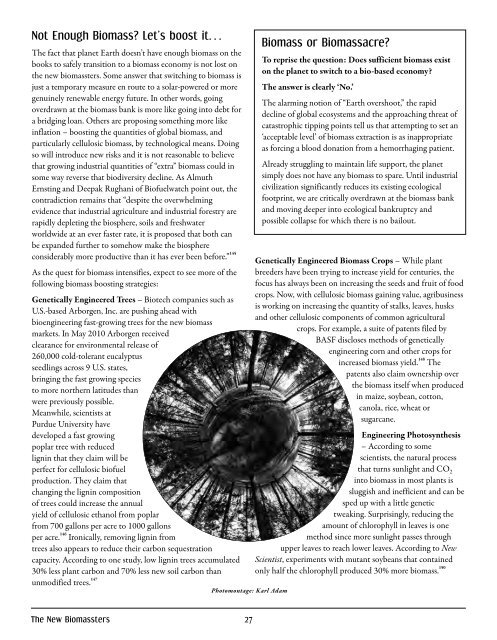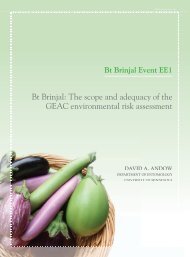English - pdf - 2145 Kb - Biosafety Information Centre
English - pdf - 2145 Kb - Biosafety Information Centre
English - pdf - 2145 Kb - Biosafety Information Centre
- No tags were found...
You also want an ePaper? Increase the reach of your titles
YUMPU automatically turns print PDFs into web optimized ePapers that Google loves.
Not Enough Biomass? Let’s boost it…The fact that planet Earth doesn’t have enough biomass on thebooks to safely transition to a biomass economy is not lost onthe new biomassters. Some answer that switching to biomass isjust a temporary measure en route to a solar-powered or moregenuinely renewable energy future. In other words, goingoverdrawn at the biomass bank is more like going into debt fora bridging loan. Others are proposing something more likeinflation – boosting the quantities of global biomass, andparticularly cellulosic biomass, by technological means. Doingso will introduce new risks and it is not reasonable to believethat growing industrial quantities of “extra” biomass could insome way reverse that biodiversity decline. As AlmuthErnsting and Deepak Rughani of Biofuelwatch point out, thecontradiction remains that “despite the overwhelmingevidence that industrial agriculture and industrial forestry arerapidly depleting the biosphere, soils and freshwaterworldwide at an ever faster rate, it is proposed that both canbe expanded further to somehow make the biosphereconsiderably more productive than it has ever been before.” 145As the quest for biomass intensifies, expect to see more of thefollowing biomass boosting strategies:Genetically Engineered Trees – Biotech companies such asU.S.-based Arborgen, Inc. are pushing ahead withbioengineering fast-growing trees for the new biomassmarkets. In May 2010 Arborgen receivedclearance for environmental release of260,000 cold-tolerant eucalyptusseedlings across 9 U.S. states,bringing the fast growing speciesto more northern latitudes thanwere previously possible.Meanwhile, scientists atPurdue University havedeveloped a fast growingpoplar tree with reducedlignin that they claim will beperfect for cellulosic biofuelproduction. They claim thatchanging the lignin compositionof trees could increase the annualyield of cellulosic ethanol from poplarfrom 700 gallons per acre to 1000 gallonsper acre. 146 Ironically, removing lignin fromtrees also appears to reduce their carbon sequestrationcapacity. According to one study, low lignin trees accumulated30% less plant carbon and 70% less new soil carbon thanunmodified trees. 147Photomontage: Karl AdamBiomass or Biomassacre?To reprise the question: Does sufficient biomass existon the planet to switch to a bio-based economy?The answer is clearly ‘No.’The alarming notion of “Earth overshoot,” the rapiddecline of global ecosystems and the approaching threat ofcatastrophic tipping points tell us that attempting to set an‘acceptable level’ of biomass extraction is as inappropriateas forcing a blood donation from a hemorrhaging patient.Already struggling to maintain life support, the planetsimply does not have any biomass to spare. Until industrialcivilization significantly reduces its existing ecologicalfootprint, we are critically overdrawn at the biomass bankand moving deeper into ecological bankruptcy andpossible collapse for which there is no bailout.Genetically Engineered Biomass Crops – While plantbreeders have been trying to increase yield for centuries, thefocus has always been on increasing the seeds and fruit of foodcrops. Now, with cellulosic biomass gaining value, agribusinessis working on increasing the quantity of stalks, leaves, husksand other cellulosic components of common agriculturalcrops. For example, a suite of patents filed byBASF discloses methods of geneticallyengineering corn and other crops forincreased biomass yield. 148 Thepatents also claim ownership overthe biomass itself when producedin maize, soybean, cotton,canola, rice, wheat orsugarcane.Engineering Photosynthesis– According to somescientists, the natural processthat turns sunlight and CO 2into biomass in most plants issluggish and inefficient and can besped up with a little genetictweaking. Surprisingly, reducing theamount of chlorophyll in leaves is onemethod since more sunlight passes throughupper leaves to reach lower leaves. According to NewScientist, experiments with mutant soybeans that containedonly half the chlorophyll produced 30% more biomass. 150The New Biomassters 27











